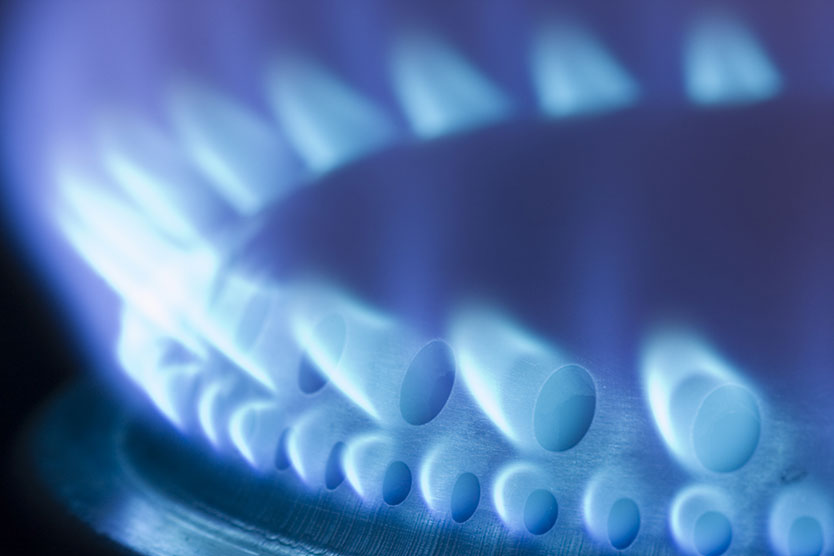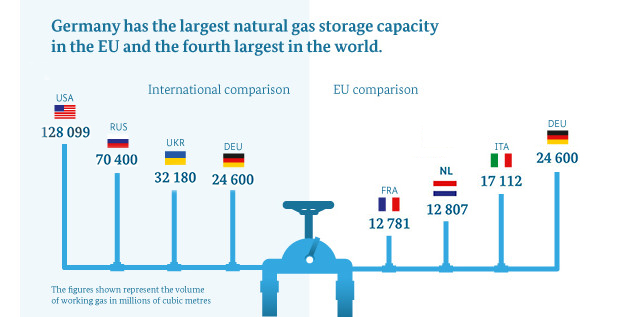Natural gas supply in Germany
Natural gas has a wide range of possible uses
Natural gas will continue to make a significant contribution to energy supply in Germany over the coming decades. The heat market is still by far the most important market for natural gas. Nowadays, however, the use of gas is not restricted solely to heat generation. In addition to its role as a raw material primarily in the chemical industry, gas is a flexible and versatile energy source for generating electricity, storing energy and – looking to the future – as a storage facility for renewable electricity as well as for mobility. Natural gas is also more climate-friendly compared to other fossil fuels as it produces less CO2. Finally, as a cheaper and more climate-friendly fuel, natural gas is also playing an ever more important role in the area of mobility.
With the appropriate level of processing, biogas (biomethane) can be upgraded to the quality of natural gas and fed into the existing natural gas grids. It can therefore help to reduce the burden not only on the heat market, but also on electricity and fuels.
With the electricity generated from renewable sources varying considerably depending on factors such as weather conditions and season, natural gas-fired plants can play an important role in offsetting such fluctuations.
Another important and promising use for the natural gas grid is emerging. By converting electricity from renewable sources into hydrogen or methane and feeding it into the natural gas grid, the latter could serve as a huge reservoir for several billion kilowatt hours (kWh) of energy. A number of very encouraging research and demonstration projects aimed at using this technology on a large scale over the next decade are currently underway.
Natural gas is the second most important primary energy source in Germany’s energy mix, after petroleum. In 2016, its share of primary energy consumption (i.e. the total amount of energy used in a country each year) amounted to 22.6%. According to the Arbeitsgemeinschaft Energiebilanzen e.V. (Working Group on Energy Balances - AGEB), domestic consumption in Germany stood at 3,022 PJ (LHV).
Europe’s biggest gas markets are Germany, the United Kingdom and Italy. Germany will in future continue to be highly dependent on imports of natural gas. In relation to this issue, serious consideration of whether and to what extent any future extraction of natural gas from unconventional deposits (tight gas, shale gas, coal gas [coal bed methane, firedamp], aquifer gas and gas hydrate) would be able to decrease this share further is still not possible at the present time (cf. also study by the Federal Institute for Geosciences and Natural Resources: “Schieferöl und Schiefergas in Deutschland - Potenziale und Umweltaspekte” (in German) (Shale oil and shale gas in Germany - potential and environmental aspects).
The growth in domestic demand is largely determined by trends in consumption in the individual sectors. In private households, natural gas is the most important energy source on the heat market, accounting for approximately 44%. Here, more than 90% of natural gas is used as a source of heating.
Natural gas and biogas (biomethane) as fuel are important elements in the fuel mix of the future. According to the Federal Motor Transport Authority, 80,300 bivalent passenger cars powered by natural gas were registered on 1 January 2016, and 475,711 LPG passenger cars. In Germany, there are currently 882 natural gas filling stations.
Infrastructure
The pipelines which go to make up the gas grid are essential for transporting and distributing natural gas. They enable widely varying quantities of gas to be delivered safely over long distances. Considerable amounts of gas are transported across Germany to other EU states. The map below shows the main natural gas pipelines in Germany as well as the points at which they cross the border from and into other countries:
In addition to this is a closely intermeshed network for distributing gas right through to the end consumer. The total length of Germany’s gas grid is 511,000 km.
The EU’s Third Internal Energy Market Package created a planning instrument for setting up and preserving a network infrastructure required to achieve a unified single market. According to this, the long-distance grid operators must regularly present a ten-year Network Development Plan to the regulatory authorities. In line with the Energy Industry Act, which was revised in response to the internal market package in June 2011, the long-distance grid operators presented their first nationwide Gas Network Development Plan in accordance with Section15a on 1 April 2012. The amendments to Sections 15a and 15b of the Energy Industry Act, which entered into force on 1 January 2016, altered the annual ascertainment of the need to expand the grid to every two years in order to avoid overlapping between the production of the Gas Network Development Plan and the drafting of the scenario framework for the following Plan. In every even calendar year, a joint national Network Development Plan must be presented, and in every odd calendar year there must be a joint implementation report, starting on 1 April 2017.
The Gas Network Development Plan includes measures for the expansion of the network in line with demand and for ensuring secure supply and safe and reliable network operation.
On 1 September 2015, the Federal Network Agency completed the procedure for the fourth Gas Network Development Plan. The Gas NDP 2015 lists 84 measures for expanding the national gas infrastructure. The planned investments include grid expansion amounting to 810 km as well as the construction and expansion of compressors with an increase in capacity of 393 MW. The investment volume will increase to a total of €3.3 billion by 2025. Further information can be found here (in German).
On 18 November 2015, the European Commission presented a revised list of Projects of Common Interest, the PCI List. It contains 195 infrastructure projects in the energy sector - 108 projects for electricity, 77 for gas, seven for oil and three for smart grids. The PCI List can be found here. It was updated in 2017. A map of ongoing and completed energy infrastructure projects can be found here.
The PCI projects enjoy expedited approval procedures and enhanced regulatory conditions. The approval procedures for this must be completed within 3.5 years, and only a single national authority should be responsible for the project management. In Germany, this is the Federal Network Agency (BNetzA). In certain circumstances, companies can apply for financial assistance under the Connecting Europe Facility. €5.35 billion is available from the EU for the 2014-2020 period.
Regulation and trade
The Federal Network Agency and the regulatory authorities for the Länder are responsible for regulating the electricity and gas supply grids.
The German gas market is characterised by a large number of privately organised operators in the areas of networks, storage operations and gas trading. There are currently two market areas in Germany (NCG and Gaspool), each with their own coordinator who ensures that access to the gas grid and market activities are both carried out in an efficient fashion. There are currently 16 gas transmission system operators in Germany. Other players are the distribution system operators, storage facility operators and commercial enterprises.
The EU internal market package for the liberalisation of the market for electricity and natural gas, most recently amended by the Third Internal Energy Market Package, redefines the areas of activity of market players. To promote competition, the operators of gas supply networks and storage facilities are separated from natural gas trading activities.
Natural gas: import and domestic production
In 2016, overall consumption on the German gas market came to roughly 95 billion cubic metres. Demand for gas in is forecast to fall slightly in future due, among other things, to technical progress and energy conservation.
Prospective regions, natural gas fields and characteristic natural gas structures
Domestic production of natural gas, although falling slightly, is currently sufficient to cover just under 6% of gas consumption (Infographic; in German). In 2016, it amounted to around 8 billion cubic metres. Germany will therefore continue to be highly dependent on imports of natural gas in future. At present, just under 94% of overall demand is supplied by other countries exclusively via pipelines. According to provisional data from the Working Group on Energy Balances, the proportion of gas purchased from Norway stood at 31% in 2016, with 22% coming from the Netherlands and 41% from other sources. The Federal Office for Economic Affairs and Export Control publishes the price for German imports of gas.
The Federal Statistical Office undertakes monthly surveys of the gas industry.
The strong dependence on imports means that the instruments for ensuring security of gas supply are vital. You can find out more about the instruments to safeguard the security of the gas supply here.
Prices and costs
As is the case for other goods and services, natural gas prices are not regulated but are set according to supply and demand. Prices are based on different cost components.
Acquisition costs include the gas purchase price and transport costs. Distribution costs are all the costs involved in transmitting natural gas to the end customers. These costs also include all costs associated with the expansion and maintenance of the natural gas grid.
The natural gas tax is based on the Energy Tax Act under which the level of natural gas consumption in the various areas of application is taxed.
Where network operators use public land for laying and operating gas pipelines, they must pay the concession fee to the respective local authority.
You can find out more about the gas prices here.

